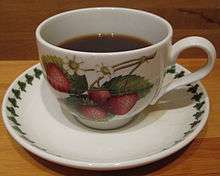Portmeirion Pottery
Portmeirion is a British pottery company based in Stoke-on-Trent, England.
| Private | |
| Industry | Pottery |
| Founded | 1960 |
| Founder | Susan Williams-Ellis & Euan Cooper-Willis |
| Headquarters | , |
| Website | www.portmeirion.co.uk |
History
Portmeirion Pottery began in 1960 when pottery designer Susan Williams-Ellis (daughter of Sir Clough Williams-Ellis, who created the Italian-style Portmeirion Village in North Wales[1]) and her husband, Euan Cooper-Willis, took over a small pottery-decorating company in Stoke-on-Trent called A. E. Gray Ltd. Susan Williams-Ellis had been working with A.E. Gray for some years, commissioning designs to sell at the gift shop in Portmeirion Village, the items bearing the backstamp "Gray's Pottery Portmeirionware". In 1961, the couple purchased a second pottery company, Kirkhams Ltd, that had the capacity to manufacture pottery, and not only decorate it. These two businesses were combined and Portmeirion Potteries Ltd was born.
Susan Williams-Ellis' early Portmeirion designs included Malachite (1960), Moss Agate (1961) and Talisman (1962).[2] In 1963, she created the popular design Totem, an abstract pattern based on primitive forms coupled with a cylindrical shape.

She later created Magic City (1966) and Magic Garden (1970), but arguably Portmeirion's most recognised design is the Botanic Garden range, decorated with a variety of floral illustrations adapted from Thomas Green's Universal or-Botanical, Medical and Agricultural Dictionary (1817), and looking back to a tradition begun by the Chelsea porcelain factory's "botanical" designs of the 1750s. It was launched in 1972 and, with new designs added periodically, is still made today,[3] the most successful ceramics series of botanical subjects.[4] More recent designs have included Sophie Conran's Crazy Daisy and Dawn Chorus.
On 23 April 2009, Portmeirion Potteries Ltd purchased the Royal Worcester and Spode brands, after they had been placed into administration the previous November. Portmeirion Potteries has since changed its company name to Portmeirion Group to reflect this acquisition.[5] The purchase did not include the manufacturing facilities of Royal Worcester or Spode. The manufacture of much of Spode's ware was returned to Britain from the Far East, to the Portmeirion Group's factory in Stoke-on-Trent.[6]
In 2019 the Victoria and Albert Museum mounted an exhibition of Portmeirion pottery.[7]
References
- which was used as the setting for the cult British television show "The Prisoner", which ran from 1966-1967
- "Portmeirion pottery in the 60s". www.retrowow.co.uk. Retrieved 2019-11-18.
- Jenkins & Mckay Portmeirion Pottery (2000)
- "Botanic Garden" is no. 5 in "Appendix A: 100 Most Popular Patterns" listed from the records of Replacements.com and illustrated in Shax Riegler. 2011. Dish: 813 Colorful, Wonderful Dinner Plates pp256ff.
- David Johnson, Article in The Staffordshire Sentinel on 16.12.10, The Sentinel
- "Stoke kilns fired up for Spode again". Staffordshire Sentinel. Nortchliffe. 2009-04-24. Archived from the original on 2009-04-26. Retrieved 2009-04-25.
- "Portmeirion: Pottery Trendsetter". Victoria and Albert Museum. Retrieved 29 March 2019.
Further reading
- Jenkins, Stephen, & Mckay, Stephen 2000. Portmeirion Pottery. Richard Dennis. ISBN 0-903685-78-7.